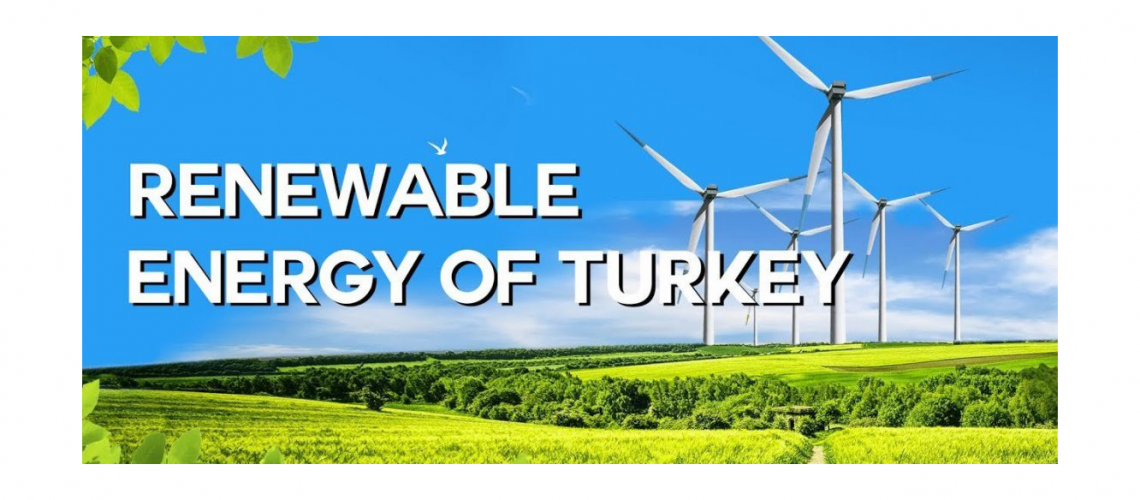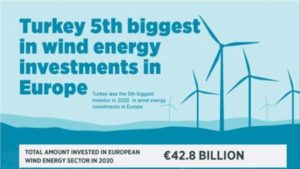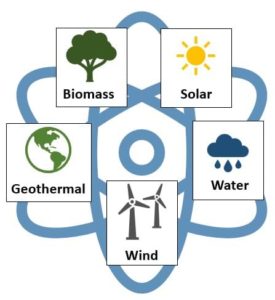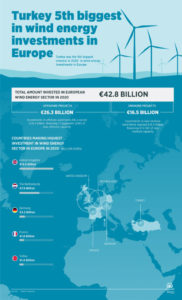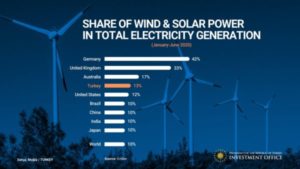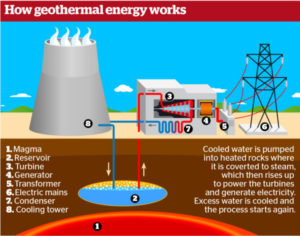The government is shifting towards renewable energy in Turkey. Turkey’s ecosystem has not been immune to the negative consequences of a global warming trend. The Taurus Mountains, Pamukkale, and the Mediterranean Sea are all suffering from the effects of global warming. Turkey has turned its focus toward being a healthier, more environmentally friendly society in response to scientific research and diminishing arability in some rural areas.
Renewable Energy in Turkey Overview:
The Turkish government has proclaimed its objective to draw at least 30% of its electricity supply from renewable energy sources by 2023. Turkey renewable energy target, Turkish officials plan to implement a number of renewable energy development schemes to meet this goal, many of which derive from the country’s now-annual clean energy conference in Istanbul.
The Turkish International Renewable Energy Congress (TIREC) has established itself as a must-attend event for clean energy enthusiasts all around Eurasia. The TIREC brings together investors and professionals for Turkey’s renewable energy investments from throughout the area. They are allowing some of the most well-known brands in the green industry to interact with like-minded wind, solar energy in Turkey, and geothermal power providers.
Useful for Rapid Economic Growth:
Turkey’s growing sustainable Energy sector in Turkey is related to the country’s rapid economic growth. Turkey’s population and GDP have grown quickly in recent years as it has become a growing cradle of commerce for European and Asian countries. Turkey’s energy demand increased by more than 9% between 2010 and 2011, an almost unparalleled rate for a developed country. Rather than increasing Turkey energy imports from Russia or Azerbaijan, regulatory organizations have turned to clean energy to meet these demands. Some renewable energy companies in Turkey are helping with it.
It has taken a long time for the focus to shift to domestic electricity generation. Turkey and its windy beaches are known for their untapped potential in the field of wind energy. It is growing its wind power capacity by 20 times by Turkey renewable energy 2020. Architects and civil engineers are also going above and beyond to make this a reality. A mosque in Bursa is being built that will generate 120 kilowatts of electricity in Turkey each day, much of it from a wind turbine attached to its construction. The Nilüfer Trade Center Mosque, which is scheduled to open in 2015, will use just about 50 kilowatts per day. The rest will be sold to the government.
It shouldn’t be long before Turkey becomes a big player in the sustainable energy industry if it continues to roll out projects like these to complement its national-sponsored initiatives. And, more crucially, it shouldn’t be long before it reduces its environmental impact significantly.
Top Priorities of Energy in Turkey:
Energy is one of Turkey’s most important development priorities. The energy demand of Turkey will be doubled between the years 2000 – 2010 and will be fivefold between 2000 – 2025. This rapid increase in demand is due to the high economic development rate of Turkey. The estimated number of Turkey’s renewable energy investments for the production facilities by the year 2010 is around 55 billion dollars. In recent years, the average increase in electricity consumption has been 8 to 10 % a year. And it is projected to maintain a similar rate in the coming years.
The energy strategy of Turkey is multi-dimensional. On the flip, Turkey, for its expanding energy need, pursues policies to ensure diversified, reliable, and cost-effective supply sources. In contrast, the process of liberalizing the Turkish energy market is continuing. The third aspect of its energy strategy is to become a major Turkey energy consumption and transit terminal in the region. The gap in Turkey’s energy supply and demand is one of the key elements which determine its energy policy. With its emerging and rapidly growing economy, Turkey is facing a rising growth of its demand for energy by 8% per annum, whereas the world average is 1.8%.
Turkey Energy Consumption:
Turkey’s energy consumption in 2000 was 82.2 million tons of oil equivalents (Mtoe). It is around 179 Mtoe by 2010 and 319 Mtoe by 2020. Indigenous energy production to meet the energy demand is around 33% in 2005, 30% in 2010, and 26% in 2020. Turkey’s primary energy resources are quite diversified; hard coal, lignite, asphaltite, oil, NG, Turkey’s hydroelectric resources, geothermal, wood, animal, and consumed.
Although Turkey’s oil and NG reserves seem limited, coal reserves are quite abundant. Turkey’s share of natural energy resources in terms of world reserves is coal 0.6%, geothermal energy 0.8%, and hydroelectric energy 1%, though petroleum and natural gas reserves are quite limited. In Turkey, lignite has the biggest share in total primary energy production by 43%.
In 1995, natural gas production was 183 million cubic meters (mcm), while imports were about 6.8 billion cubic meters. Turkey’s natural gas production is met only 2.8% of the total domestic consumption. The country consumed 16.1 bcm of natural gas in 2001. Turkey’s natural gas consumption is to grow by 64 bcm projected in Turkey renewable energy 2020.
Some Interesting Facts:
Some interesting facts about the Energy sector in Turkey are shown here.
- In terms of hydropower resources, Turkey is a wealthy country.
- Although the present installed hydroelectric capacity is positive, with around 28.5 GW total – 8 GW from river plants and 20.5 GW from reservoir dams – there is still up to 50 GW of extra economically viable capacity. It represents a superb Turkey’s international energy strategy.
- Turkey could generate 300 % more electricity each year.
- As of 2020, hydropower accounted for more than half of Turkey’s total installed renewable energy capacity. The Turkey renewable energy 2021 will enhance.
- GE Renewable Energy completed the 500 MW Lower Kaleköy Hydropower Plant at the Lower Kaleköy Dam in Turkey in February 2021.
- Turkey now has an installed renewable energy capacity of about 6,400MW.
- Due to large-scale Turkey’s renewable energy investments, the country is rapidly expanding renewable energy, particularly hydropower. As a result, Turkey’s total renewable capacity climbed to 44.5 GW in 2019 from 31.5 GW in 2015.
- As a result of factors like initiatives to reduce electricity, Turkey energy imports, reliance on fossil fuels, and the introduction of renewable energy companies in Turkey, the hydropower category is expected to maintain its dominance over the projection period.
- Turkey already has a large number of renewable energy facilities in operation, completing the Turkey renewable energy target. The Susurluk Hydroelectric Power Plant, with a capacity of 1,410MW, is the largest.
- Turkey is the first country to establish a 1 GW solar power plant. It contributes significantly to total electricity generation, thanks to good conditions for growing solar and wind power in Turkey resources.
Turkey’s Major Energy Assets:
Turkey also has a lot of, Turkey renewable energy 2021, energy potential. Solar in its different forms, wind, biomass, nuclear energy in Turkey, hydro, and geothermal, are the most significant renewable Turkey’s major energy assets for the Energy sector in Turkey. Turkey’s geographical location offers a number of benefits for making full use of renewable energy sources. Solar energy in Turkey, which is abundant in Turkey, may initially be used to supply affordable hot water for home and commercial usage, as evidenced by the quick growth of this technology in other nations in the region. You will also see the development of nuclear energy in Turkey.
Accelerating this renewable energy development through a more intense investment program can help to replace a large portion of the electrical load while also reducing the requirement for fossil fuels.
Biomass Energy in Turkey:
In rural Turkey, biomass is the primary source of renewable energy in Turkey. Biomass is used to generate new power in Turkey, heat houses, fuel automobiles, and provide process heat for industrial operations, among other things. Turkey’s yearly biomass potential is estimated to be at 32 Mtoe. The overall recoverable bio-energy potential is estimated to be at 16.92 million tonnes of oil equivalent (Mtoe).
Domestic energy use accounts for roughly 37% of overall Turkey energy consumption. Biomass-based fuels account for around 52 % of this total. In Turkey, agricultural leftovers such as grain dust, wheat straw, and hazelnut shell are available as biomass energy sources. Turkey produces around 2.6 x 107 tonnes of wheat straw each year.
The hazelnut shell is a potentially valuable energy source, with an estimated yearly production of 3.5 105 tonnes in Turkey. The hazelnut shell has a higher heating value of 19.2 MJ/kg and a calorific value of around 1.9 106 kWh. The steam gasification process can be used to transform these agricultural leftovers into hydrogen-rich gaseous products.
In rural Turkey, wood is the primary source of energy. In Turkey, wood accounts for 9.7% of total primary energy consumption. Turkey produces 19.9% of its primary energy from wood.
Biogas, the anaerobic fermentation result of animal dung, has a production capacity of 2.2–3.9 billion m3 per year, or 1–2 million toes if all manure is used for biogas production. Dung gas accounts for about 85% of overall biogas potential, with landfill gas accounting for the rest. Sheep, cattle, and poultry provide 50%, 43%, and 7% of the dung gas potential, respectively. In the Central Anatolian region, an average of 80–100 tons wet biomass (25 to 30 tons useable biomass) per hectare can be obtained.
Hydropower Energy in Turkey:
Thermal power plants (TPPs) that use coal, natural gas, lignite, fuel oil, and geothermal energy, as well as hydropower plants, provide electricity in Turkey (HEPPs). Turkey has an annual gross hydro potential of 433,000 GWh, accounting for over 1% of the global total.
The remaining hydropower potential production of 69,326 GWh per year is expected to be used by 329 additional Turkey’s hydroelectric resources and facilities in the future. In 2002, the overall new power in Turkey usage reached 126.9 GWh. It will be increased to 265 GWh in 2010 and 528 GWh in 2020.
Turkey’s Electricity Generation and Transmission Corporation’s projections work on it. It is one of the tops publicly traded renewable energy companies in Turkey. This firm owns and runs 15 thermal and 30 hydroelectric plants in Turkey, which generate 91% of the country’s electricity. They predict that during the next 15 years, rapid (as high as 10% yearly) growth in electricity demand will continue.
The Euphrates and Tigris River basins have the most hydropower potential, accounting for 45 % of the total; 29 % of this capacity is already exploited in active HEPPs, while 4 % is under development. The remaining HEPPs with a capacity of more than 10 MW have limited water resources and are used for peak demand.
The projects in the Euphrates Basin have a total installed capacity of 5304 MW and will generate 20 GWh of energy. This basin will be home to 14 dams and 11 hydroelectric power units.
Turkey’s small hydroelectric plant (SHP) resources are expected to be 710 GW for project production and 300 MW for total capacity. Over the last 25 years, annual improvements in SHP capacity have averaged 8–12%. According to ICOLD’s guidelines, the majority of these dams are of sufficient size.
Wind Energy in Turkey:
Due to a lack of data, the potential of wind power in Turkey could not be determined with certainty. In Turkey, there are a number of areas with relatively high wind speeds. The Marmara, Southeast Anatolian, and Aegean are the most appealing regions for wind energy use.
Wind power potential in Turkey could be as high as 120,000 MW, with particularly appealing wind locations located along the west coast and in southeastern Anatolia. Bozcaada has the maximum wind speed of 6.36 m/s and the highest wind density of 319.5 W/m2 s. 6.4 m/s at Karaburun and Karabiga, 7 m/s in Senkoy, and 7.1 m/s in Nurdagi are the highest wind speed readings reported in the literature. In Bandirma, the highest wind density was measured at 152.6 W/m2.
During the year 2000, a total of 3,800 MW of wind energy generating capacity was brought online throughout the world. It is bringing the total installed capacity to around 17,300 MW. It is enough to generate around 37 GWh of power annually.
The total land eligible for this capacity is about 1.3 % of Turkey’s total area. In addition, the amount of wind power in Turkey generated in 2018 was predicted to be 19,882 GWh, with a potential of 7005 MW for active wind energy projects. The current projects are expected to yield an 11GW reserve. Turkey also plans to have a wind energy capacity of 20 GW by 2023. It is the main Turkey renewable energy target.
Solar Energy in Turkey:
Solar energy is the most important of the alternative renewable energy sources in Turkey. The solar energy in Turkey potential is projected to be 26.4 million toes in terms of thermal energy and 8.8 million toes in terms of electrical energy. Solar energy is commonly used for heating, and solar energy consumption had increased from 5 Ktoe in 1986 to 335 Ktoe in 2003.
Turkey produced roughly 600 Ktoe of solar energy in 2010. In Turkey, PV power uses are confined to a few governmental organizations that employ PV to meet remote electricity demand. Telecom stations, fire observation stations, lighthouses, and highway emergency systems are some of the most common applications. The total installed energy is estimated to be roughly 398 MWac. The average solar thermal sun time in Turkey is 2700 hours per year. With a total capacity of 8.2 million m2 collector area, Turkey is one of the world’s leading countries. The industry has advanced to the point that it can produce high-quality goods and export them.
Geothermal in Turkey:
Turkey has large geothermal power potential, accounting for one-eighth of the world in the field of total geothermal potential. It shows a great Turkey’s international energy strategy. Turkey’s total geothermal potential is estimated to be at 38,000 MW (electric and thermal). Around 88 % of this potential is much more suitable for thermal use (temperature less than 423 K) and the rest for power generation (temperature more than 423 K). However, geothermal energy production in 2001 was only 1.759 million tons of oil equivalent. By Turkey renewable energy 2020, its consumption is expected to be around 6.3 Mtoe, primarily for direct heating.
Turkey’s total installed direct heating capacity was 820 thermal MW. A total of 390 MW of electricity is used to heat 51,600 homes. Around 100 MW is used to heat about 45 hectares of greenhouses. By 2010, geothermal energy in Turkey has heated over 500,000 homes, equating to about 3,500 megawatts of capacity.
Turkey Mineral Studies and Exploration Institute conducted the first geothermal research and investigations around the era of the 1960s. The research discovered around 170 geothermal fields. Due to this factor, around 95 % of them being low, medium enthalpy fields. They’re best suited to direct-use applications.
Biomass and hydropower are the most often used energy sources, with geothermal coming in third. The geothermal energy form of electricity generation accounts for only 0.09 % of Turkey’s total electrical capacity. However, by 2020, the rate will have improved to 0.32 %.
The Final Thought:
Turkey has numerous renewable energy resources that are useful. It is including geothermal, hydro, biomass, wind, and sun. Except for hydroelectric electricity, Turkey currently has no demonstrable success in renewable energy. Turkey has a substantial market for Turkey renewable energy 2021 and energy efficiency.
Resource estimation studies of renewable energy sources for being conducted by relevant agencies. Biomass potential is assumed to exist in densely populated areas, which can be exploited to generate energy in Turkey.
Meta
It is true that there is a large potential for renewable energy in Turkey as the geographical position is suitable for its use in all regions and seasons.

